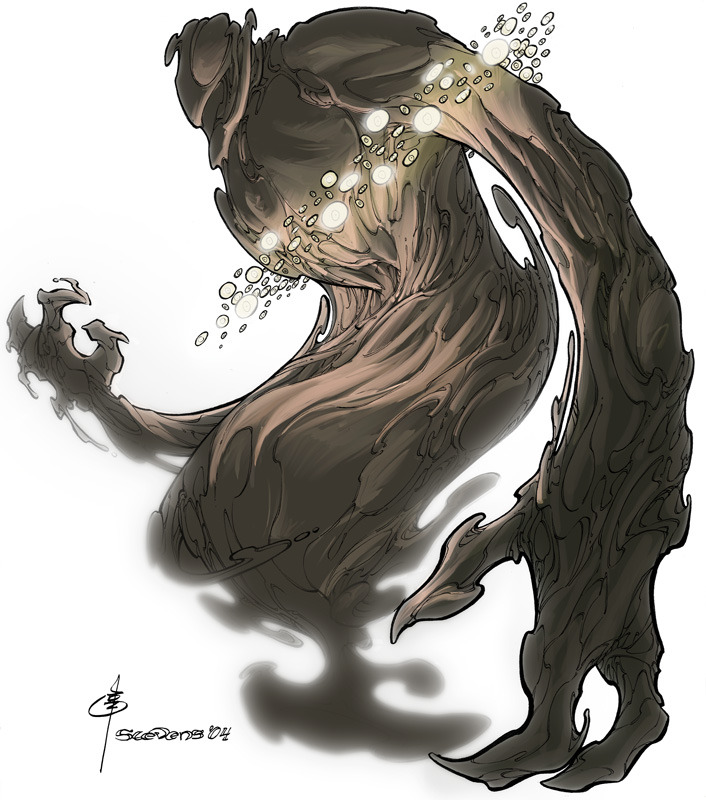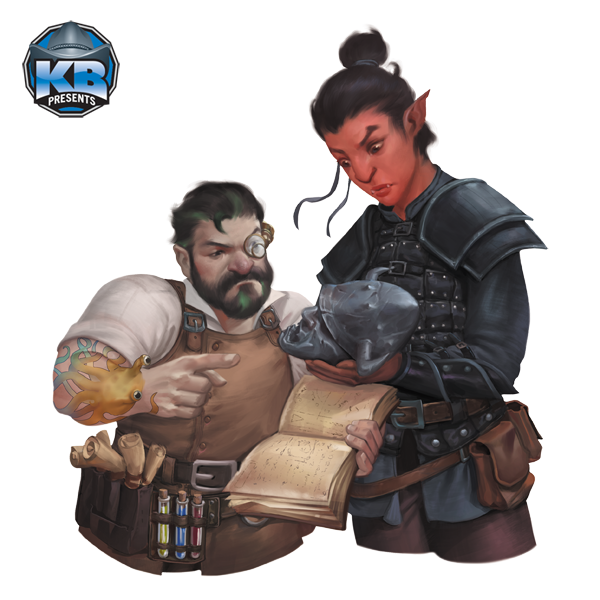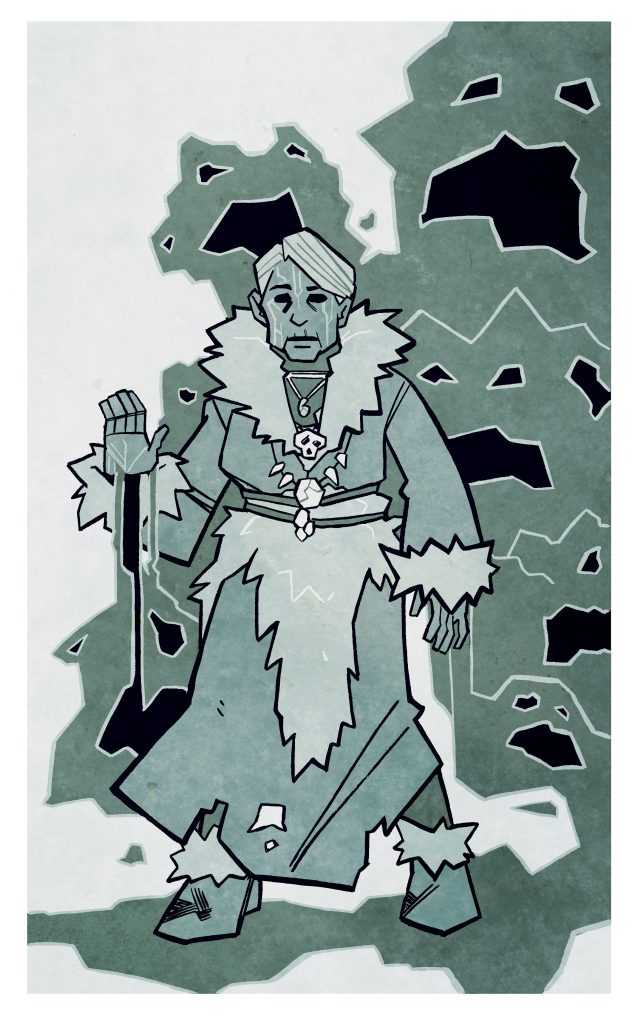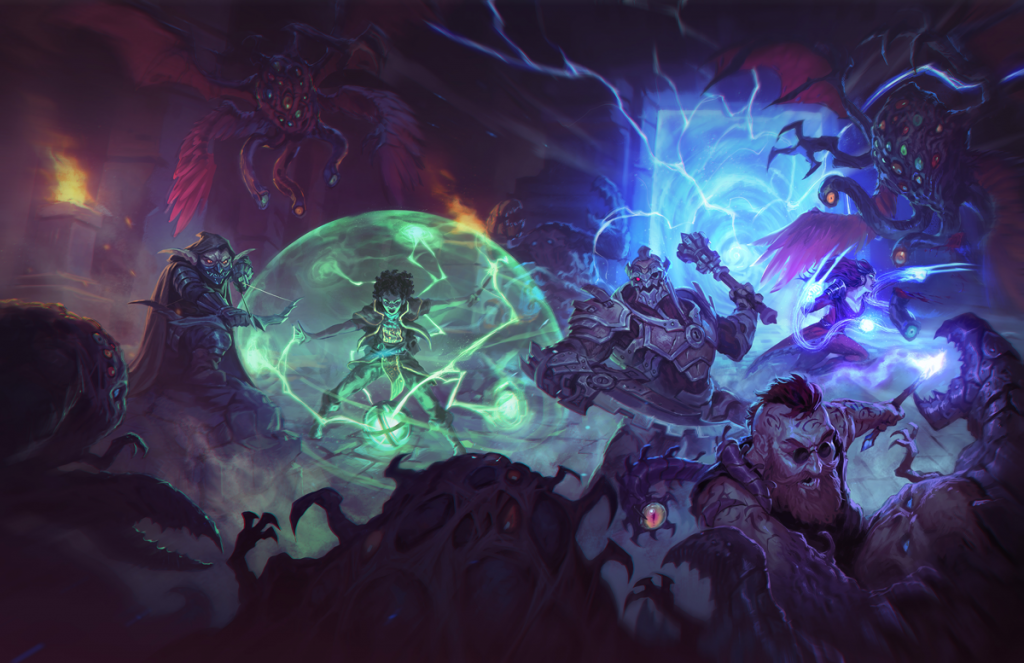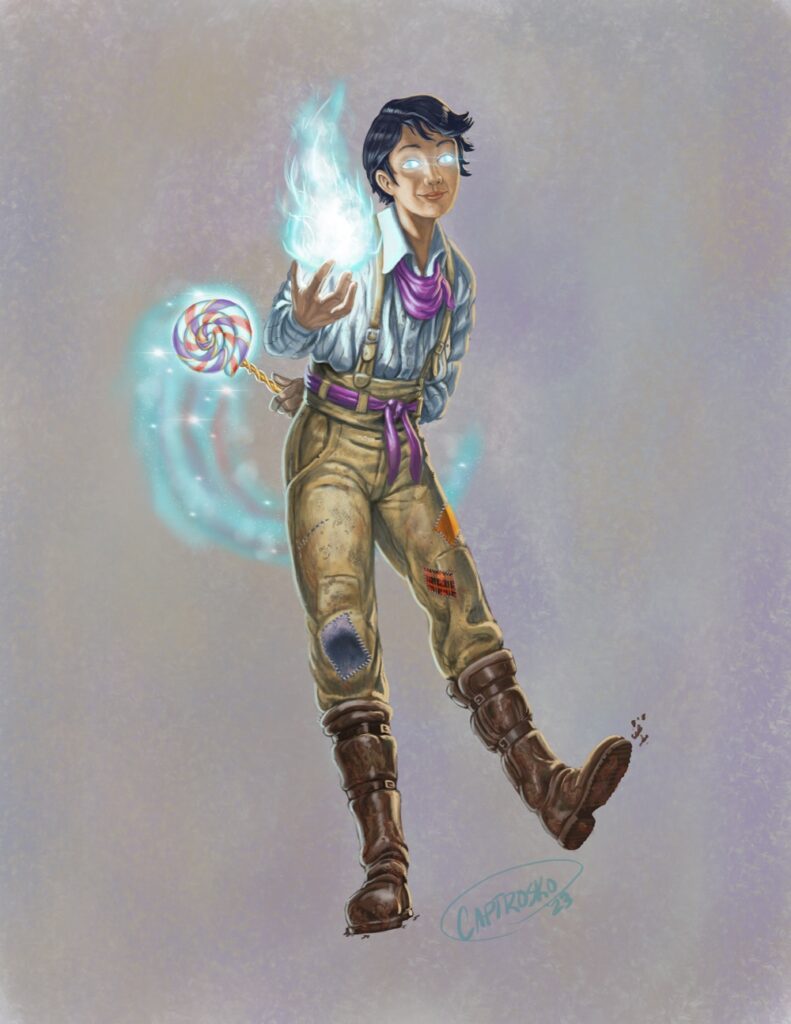
As time permits, I like to answer interesting questions posed by my Patreon supporters. Here’s one from this month…
In a campaign in which the Dreaming Dark is the primary villain, would the Kalashtar be the right quest-givers? How aware are the Kalashtar of the schemes of the Dreaming Dark? How would Kalashtar or other NPCs learn of Dreaming Dark plots?
So first of all, this question is sort of like saying In a campaign in which the daelkyr are the primary villains, would the orcs be the right quest-givers? To which the answer is that Gatekeepers would be the most likely quest givers. Ghaash’kala orcs, Jhorash’tar orcs, a Tharashk inquisitive working the mean streets of Sharn—they’re not going to know anything about the daelkyr. This is key here because the automatic answer is that followers of the Path of Light are an excellent option for drawing adventurers into the schemes of the Dreaming Dark. But not all kalashtar follow the Path of Light, and even among those that do there are different approaches among the faithful. A few quick points to keep in mind…
- The kalashtar have been separated from Dal Quor for almost two thousand years. The rebel quori escaped Dal Quor before Riedra existed as a nation. So it’s not like they split off a few years ago and have lots of inside info. Especially because…
- The kalashtar don’t dream in Dal Quor. Contrary to popular belief, kalashtar DO dream. Their dreams are formed from their own memories and subconscious and those of their linked quori spirit. But because they don’t dream in Dal Quor, they can’t be affected by dream and more important, they can’t actually spy on the Dreaming Dark in Dal Quor. Within Adar, there are human devotees of the Path of Light who are trained to serve as dream-spies, going where kalashtar can’t. So the Adaran Path of Light has access to some inside information, but that’s because of their human agents.
- Kalashtar can’t usually talk to their quori. Kalashtar don’t have casual conversations with their guiding spirits; instead, they are guided by instincts and visions. It’s something that could happen under exceptional circumstances. The most common would be a kalashtar spellcaster framing their divination magic as communicating with their quori, but as a DM you could have a kalashtar get a direct message from its quori in a dream vision or something similar. But it’s not normal. The kalashtar feel the presence of their guiding spirit, but they can’t just say “Ashana, tell me everything you know about the Dreaming Dark“… and likewise, it’s possible for an orphan kalashtar to fail to recognize the nature of their spirit, just believing they have interesting dreams and strong hunches.
- Kalashtar are at least latently psionic and could be sensitive to psychic disturbances. And this can be a key to the adventure hook. Kalashtar don’t have a direct backdoor into the plans of the Dreaming Dark. But the Path of Light is aware of the Dreaming Dark, and kalashtar in general may be able to sense when something is off—when quori have been manipulating emotions, mind seeding people, etc. This isn’t something concrete or reliable like a paladin’s Divine Sense. But as a story device, a DM could certainly say You feel something wrong here, Virashana… a pervasive, unnatural sense of despair. You can feel Ashana’s concern. This same concept can easily be used as a basis for kalashtar quest-givers. They don’t KNOW the plans of the Dreaming Dark, but they feel that something is wrong… can you investigate, adventurer?
So keeping that in mind, let’s revisit the question… In a campaign about fighting the Dreaming Dark, would kalashtar be the right quest givers? They COULD be, but what that would look like would depend on the individual. A key point here is that as a DM running a long term campaign I’m usually not going to start by stating on day one The Dreaming Dark are infiltrating House Cannith and planning to create an army of warforged vessels they’ll use to conquer Khorvaire! What I want is for the players to learn about the Dreaming Dark and their greater scheme organically… to interfere with a minor scheme and then slowly get pulled deeper and deeper into it. My novel series The Dreaming Dark deals with, surprise, a scheme by the Dreaming Dark. But they don’t even get MENTIONED in Book One; there’s simply an incident in which the protagonists cross paths with a kalashtar. In Book Two the character returns to help them with a problem and avoiding spoilers, the story evolves from there. So this is a case where a kalashtar drives the story… but she doesn’t just show up in Book One and say “You must come with me now to fight the Dreaming Dark!”
Taking all that in mind, let’s consider three different kalashtar, any of which could be PCs or NPC quest givers.
TARI (pictured above) is an orphan who grew up in the Shadow Marches. They’ve never met another kalashtar and didn’t know the word until someone else used it to describe them; they still don’t really know what that means. They know nothing about the Dreaming Dark or the Path of Light, and have instead found their way to the Silver Flame. Mechanically they are a divine soul sorcerer, with their powers flavored as a blend of silver fire (guiding bolt, sacred flame) and psychic influence (charm person, hold person, detect thoughts). The idea is that all of this is largely intuitive, driven by their compassionate spirit and their unrecognized link to their quori. Tari is better suited to being a PC than an NPC; part of the point of the character is that they are connected to powerful forces they don’t yet fully understand, and that they can receive guidance and visions from both the Flame and their quori. So as a PC, Tari COULD lead the other adventurers into a scenario with the Dreaming Dark, but the idea is that they wouldn’t know what they were getting into… they’d just know that something is wrong and needs to be investigated, and THEY would learn about the Dreaming Dark along with the other adventurers as they dig deeper into the adventure.
VIRASHANA is a kalashtar soulknife rogue from Breland. She was raised in the Path of Light and knows its traditions, and if she’s in Sharn she knows people in Overlook; but overall she operates alone. She’s what the Path calls a Shadow Watcher—someone who seeks to fight evil directly and forcefully. When she was young, the kalashtar coummunity she was part of was targeted by the Dreaming Dark and her father was killed by an Inspired mindstealer. Now she craves vengeance and has devoted her life to identifying and eliminating mind seeds and other agents of the Dreaming Dark in Khorvaire.
Virashana could absolutely draw adventurers into a story, but she would likely be acting alone: she’s been conducting a personal investigation and she’s identified a threat, and she needs back-up. This story is stronger if one of the player characters has a pre-existing connection to Vira, and even if they’ve never met IN THE CAMPAIGN, this is where I might draw on a character’s background and work with the player to develop a story. Perhaps a Folk Hero, Inquisitive, or former Sentinel Martial once teamed up with Virashana to catch a murderer driven by nightmares. Maybe a former Spy got an unexpected assist from Virashana after his handler mysteriously turned on him (due to a mind seed). If the player is up for it, I might ask them to tell me about the time Virashana saved their life… establishing that she’s a mysterious woman with psychic knives who helped you out with some creepy dream business.
The main point is that Virashana can get a story rolling with her investigation, and she can share general knowledge about the Dreaming Dark, but she’s never been to Adar, she’s never actually met a Riedran Inspired, and she’s not connected to a larger network of kalashtar. She’s great for getting adventurers involved in a small, targeted scenario that will later be revealed as part of something larger. She’ll show up and say Good to see you again, Daine. What’s it been—five years since that ugly business in the Cogs? Well, it’s happening again… something to do with House Deneith. You and your friends free tonight? Dress for the sewers. She’s following a lead, she doesn’t have a lot of information, and she’s going to get her hands dirty whether you join in or not.
ALARKHAD is a kalashtar monk from Adar, sent by the elders to serve as a Lightbringer—combating the Dreaming Dark and other malevolent forces by inspiring the people around him to be better and generally bringing more light into the world. While I’ve described him as a “monk”, mechanically he’s a bard; his Inspiration and bardic magic (mainly enchantment and divination spells) are presented as psionic powers. He can definitely serve as a patron for a group of adventurers. Like the character in my novel, he might just show up when the adventurers need guidance or healing, helping to remove a psychic “curse” one of the characters has been afflicted with in an encounter with quori vessel. Unlike Virashana, he is more likely to guide and advise. Coming from Adar, he has access to a deeper knowledge base and resources, but he dislikes direct, ruthless action and beyond that, he’ll need time both to come to trust the adventurers and to prepare them for the greater conflict that lies ahead.
So after helping them in a previous adventure, Alarkhad might approach the characters and say There is a malevolent force growing in Callestan. Speak to those who are suffering there, and look closely at the agents of House Tarkanan; I cannot say with certainty that they are the source of this corruption, but they may be. He isn’t coming along. He doesn’t actually have a personal stake beyond people are suffering. He’s just letting you know something is rotten in the district of Callestan and you need to check it out. It might not even BE related to the Dreaming Dark — but if you resolve the situation compassionately, he’ll conclude you have the skills and temperament to deal with the more serious scheme he’s aware of.
But what’s the Scheme?
If I’m running a campaign in which the Dreaming Dark are the major villains, I’ll start by coming up with their BIG GOAL. As I’ve said in other places, the first thing I’ll do is pick a catspaw. The Dreaming Dark established Riedra by turning all the existing powers against one another and then presenting the Inspired as unifying saviors. They convinced the people of Riedra to forge their own chains. In my campaign, if they want to conquer Khorvaire they’ll take the same approach. They’ll push the Five Nations to tear themselves apart (canonically, there’s lots of hints that they could have set the Last War in motion) and then present a savior to fill the role of the Inspired in Khorvaire… or, potentially, a different approach that still ends with a stable pacified population, such as an army of quori-possessed warforged. So, who’s the figurehead in this scheme? It could be the ruler of one of the Five Nations; a dragonmarked house; the Twelve; a new religion; an existing religion (new zeal for the Sovereign Host!); a political movement. Whatever this is, it’s going to be something I want to develop over time. I don’t want to send 1st level characters up against THE DREAMING DARK; I want them investigating something smaller. Identify a mind seed. Investigate the actions of a strange warforged that turns out to have an impossible design. Deal with a psychic plague spreading through a bad part of Sharn. Deal with a serial killer driven by dreams. These could be trial runs of something they intend to deploy later, or dominos whose impact won’t be seen until later (the serial killer causes fear in the area which makes people more willing to accept martial law when it’s proposed). This also means that when the player characters solve the problem, they aren’t actually drawing the wrath or attention of the Dreaming Dark. The psychic plague was a trial run; the warforged was a prototype; the serial killer already served his purpose. The adventurers have triumphed and done something good for their community, but the Dreaming Dark’s plan continues to unfold.
I’m creating a smol table for randomly generating Dreaming Dark schemes as a treat for my Patreon supporters (Inner Circle and above). If that sounds like fun, check out my Patreon!
This month, patrons also asked a questions about the Quori themselves…
Are there any Lluora Quori-inspired Chosen lines in Riedra? If yes, which branch of Riedra do they serve?
This is a VERY deep cut. The Lluora quori are an idea I suggest in this article, when someone asked if there could be a quori of sloth. Here’s what I said…
“Sloth” isn’t quite the right word for a quori. The general idea is that quori specialize in developing and manipulating particular emotions or moods. So the key is that this quori—which I’ll call the Lluora—doesn’t embody sloth itself; rather, it specializes in SAPPING MOTIVATION. Consider all the tools of procrastination—creating distracting tasks or options; causing the mortal to endlessly question their decisions, paralyzing them with self-doubt; causing them to question their end goal; encouraging Whataboutism and “Why bother doing anything when nothing will ever really change?” I don’t think they’d be common. One possibility is that they’d be a sort of jailor, trapping mortals in their own mental prisons and preventing them from ever building up the motivation to escape. Another is that they’d advise kalaraq, suggesting ways to undermine mortal motivation.
So sure, there could be a Lluora line. Which branch would they serve? One immediate option is THE GUIDING PATH. The Lluora essentially specialize in preventing progress and quelling resistance by dissolving the motivation to rebel. Another option is THE THOUSAND EYES, serving in the role of jailor described above. But also, it’s important to keep in mind that not every quori specializes in administering RIEDRA. This ties to theoretical quori who deal with greed or envy. There are quori who have no role in Riedra, because their role is to serve the Dreaming Dark as it plants roots in OTHER CULTURES. The lluora CAN help the Guiding Path sap motivation. But it’s going to have a far greater impact *working in the Five Nations* helping to undermine passion and drive. Riedra is a fairly stable machine at this point; it’s Khorvaire where there’s more need to actively inflame greed, doubt, envy, and more.
But there’s another point here. If you make a new type of quori and then aren’t sure how it fits into the Dreaming Dark’s activities on Eberron, remember that QUORI DON’T BELONG ON EBERRON. That’s not why they exist. They SHOULDN’T all have a role to play on Eberron, because THAT’S NOT WHERE THEY ARE SUPPOSED TO BE. If you can think of a useful way the Dreaming Dark could use them in its schemes, that’s great. But they are supposed to have a role to play in DAL QUOR; whether there’s something for them to do on Eberron is entirely secondary.
Could you see there being 13-1 types of Quori? I wonder if it too many and I am not sure how make one of types missing.
No, personally I wouldn’t do this. The idea of a missing quori TYPE seems forced. If I was to push a Baker’s Dozen on the quori—and I probably WOULDN’T—I’d say that there are thirteen KALARAQ, but that Taratai is missing. But on reflection I think this is an unnecessary limitation. As for quori themselves, I think thirteen is too FEW. Consider how many different times of demons or devils exist! The ones we know may be the most common types, but I don’t feel a need to completely lock down how many strains there are; I like being able to add a new rare quori type if I think of something cool.
That’s all for now! I need to stockpile firewood for Long Shadows. Oh, with that in mind: I’ll be doing a live Q&A on Saturday, December 23rd at 9 AM Pacific Time for my Threshold patrons; the session will be recorded and made available to Inner Circle patrons after the fact. So, one more reason to check out my Patreon! Patreon support is what makes it possible for me to spend time on Eberron, so thanks to all of you who make this possible!

